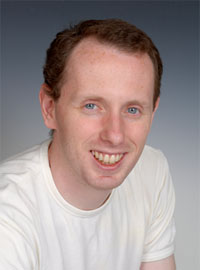Peter Boyle

Professor P Boyle
- Position
- Professor
- Category
- Academic staff
- Location
-
James Clerk Maxwell Building (JCMB)
Room 4410
- Email: paboyle [at] ph.ed.ac.uk
- Tel: +44 (0)131 650 6573
- Personal home page
- Edinburgh Research Explorer profile
Peter is a member of the following School research institute, research group and research areas:
Research institute
Research group
Research areas
Websites
Research interests
Low energy Quantum Chromodynamics using computer simulation, and particularly matrix elements of hadrons that are required to constrain fundamental parameters of the standard model and search for physics beyond the standard model. I believe my publications represent the best constraints on Vus and BK which enter the famous unitarity triangle.
Subtopics: Kaon matrix elements - BK, Kl3 , K->pi pi. Non-perturbative renormalisation of Lattice operators. Chiral lagrangian. Hadron spectrum and decay constants. Electromagnetic effects.
I am a member of the RBC-UKQCD collaboration, and collaborate with Columbia University, Southampton, Brookhaven National Laboratory, RIKEN Brookhaven Research Center, University of Virginia, University of Connecticut.
Administrative roles
Chair of STFC DiRAC Facility Technical Working Group
Member of STFC DiRAC Facility Project Management Board
Qualifications
PhD Theoretical Particle Physics,
BSc Mathematics and Physics Combined Honours
Collaborative activity
I worked under collaboration with IBM Research from 2007 until 2012 to design the level-1 prefetch engine on
the IBM BlueGene/Q compute chip.
I currently teach:
- Standard Model 5th year integrated masters
- PDE's component of Fourier analysis and Statistics 3H
I have previously taught:
- Physical Mathematics 3H
- Computational Methods 3H
Peter has featured in the following recent School news stories:
Recent publications
- , Physical Review Letters, 134, 20, p. 1-8
- , Physical Review Letters, 134, 11, p. 1-7
- Physical-mass calculation of ρ (770) and K∗ (892) resonance parameters via ππ and Kπ scattering amplitudes from lattice QCD DOI, Physical Review D, 111, 5, p. 1-28
- , Physical Review D, particles, fields, gravitation, and cosmology, 108, 5, p. 1-20

